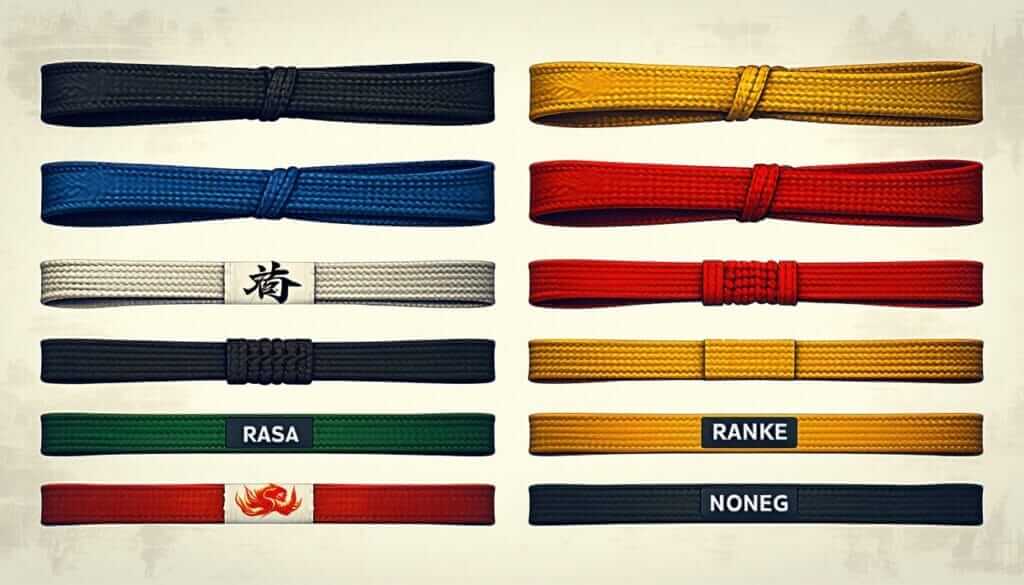History of Belt Ranks
The story of MMA belt ranks is one of tradition, dedication, and skill refinement over centuries. Getting a handle on how these ranks came to be helps peel back the layers of what they mean in martial arts.
Origin of Colored Belts
Trip back to the 1880s, and you’ll find yourself in the era of Dr. Jigoro Kano, the brains behind Judo. He kicked off the colored belt system, keeping it simple at first: white for students, black for teachers and masters. But as martial arts spread like wildfire, it was clear the belt system needed a little more pizzazz.
Enter Gichin Funakoshi, karate’s granddaddy. He upped the game by mixing in more colors like yellow, orange, green, and blue alongside the basic white and black. This rainbow approach made it easier for students to see their progress, sparking motivation and a bit of healthy competition. Check out more on.
| Year | Key Development |
|---|---|
| 1880s | Dr. Jigoro Kano brings in colored belts for Judo. |
| 1920s | Gichin Funakoshi jazzes up Karate with more belt colors. |
Evolution from White to Black
Going from a white belt to a black belt is like watching a fresh-out-of-the-package rookie become a seasoned pro. White belts are all about beginnings, untouched by experience, a blank canvas ready for martial arts lessons. As students learn and grow, those belts change colors, each shade marking a skill milestone.
When someone sports a black belt, it’s not just about the moves—they’re packing experience, wisdom, and a bit of life maturity in there too. Some say the black belt idea might trace back to mourning bands from 19th-century Japan. More on that at.
This belt progression is key, offering a clear path for growth and motivation to martial artists everywhere. The whole martial arts belt ranking symbolism spiel is not only a personal marker but also a community badge of respect.
As colors caught on, so did the variations to fit different martial arts styles, keeping in tune with different cultures and histories around the globe. Interested in learning more about the roots and tweaks of this ranking system? Dive into it with our article on martial arts belt ranking history.
Symbolism of Belt Colors
In the world of martial arts, belt colors are more than just flamboyant wardrobe choices—they tell a story. This riot of hues unveils levels of skill, knowledge, and dedication, capturing each artist’s unique journey and personal growth in every knot and tie.
White, Yellow, Orange
- White: Yep, you’re that fresh-faced newbie! Rocking the white belt? It’s your mark of birth, purity, and innocence—an introduction to martial arts. Picture it as a blank slate where anything’s possible. Usually, you’ll graduate from this belt faster than you can say “karate kid,” typically in three months if you’re putting the hours in.
- Yellow: Yellow screams hope and high-energy vibes. Making the jump to this belt? You’re no longer wandering in the wilderness; you’re catching on to the techniques and philosophies. Plus, it’s sunny. Expect another three months here, perfecting those baby steps.
- Orange: Growth and maturity start to suit you well with the orange belt, like a juicy, ripe fruit. With skills finally settling in, you’ll be working hard on your form. Plan to stick around this cozy orange zone for three to six months.
| Belt Color | Symbolism | Duration (Average) |
|---|---|---|
| White | Birth, purity, innocence | 3 months |
| Yellow | Hope, learning phase | 3 months |
| Orange | Growth, maturity | 3 – 6 months |
Green, Blue, Purple
- Green: You’re a little sprout in the world of martial arts, showing off your green belt with pride. It reflects your blossoming abilities in grappling, striking, and wrestling—skills demanding some serious self-discipline and focus.
- Blue: With the blue belt, you’ve shot straight for the sky. Setting aspirations higher, this belt is your ticket to explore advanced techniques and strategies. Time to get fancy with those moves!
- Purple: Moving onto purple means you’re witnessing the colors of dawn, signaling a new day for your martial arts journey. You’re at a stage that prepares you for some challenges that’ll test your grit.
| Belt Color | Symbolism | Duration (Average) |
|---|---|---|
| Green | Growth, refining techniques | 6 months |
| Blue | Aspiration, advanced techniques | 6 – 12 months |
| Purple | Transition, nearing proficiency | 6 – 12 months |
Brown, Red, Black
- Brown: Now you’re marinated to perfection with this shade of maturity. The brown belt tells of students sharpening their skills, gearing up to understand and maybe even teach others soon.
- Red: Behold, the red belt—your badge of caution and responsibility! It’s a shout-out that says you’re advanced and ready to shoulder the weight that comes with martial art skills.
- Black: When you earn the black belt, it’s like walking the graduation stage. You’re a master now and primed to step into your new role as instructor. Time to pass the torch (and a punch or two).
| Belt Color | Symbolism | Duration (Average) |
|---|---|---|
| Brown | Maturity, honing skills | 6 – 12 months |
| Red | Mindfulness, advanced responsibility | 6 – 12 months |
| Black | Mastery, new beginning as instructor | Varies |
Taking a peek into the mystery of martial arts belt colors can really stir some excitement. It’s more than learning new moves—it’s a blend of skill and character growth. For more juicy tidbits, why not wander over to these reads: martial arts belt colors meaning and martial arts belt ranking history? You’re sure to find something that tickles your curiosity!
Belt Ranking Systems
Belt ranking in martial arts is a bit like leveling up in a video game – reach a new level, get a new belt. Simple, right? Well, there’s more to it! Think of it as a roadmap guiding martial artists with colorful checkpoints, where every new hue marks an achievement in skill and dedication.
Progression and Recognition
Getting from one belt to another is not just for show; it’s what keeps practitioners pushing their limits. It’s one part slog, two parts test, and a sprinkle of good ol’ hard work. You gotta nail those moves, prove your chops in tests, and of course, keep showing up to those sweat-it-out classes.
The path to a black belt isn’t a sprint; it’s a marathon, no ice baths or protein shots needed! On average, it might take Karate lovers about five years to strut their stuff with a black belt around their waist. Although every martial art’s got their own way of doing things, the core message is the same: practice, discipline, and always be better than yesterday.
| Rank | Approximate Time |
|---|---|
| White Belt | Starting Point |
| Yellow Belt | 6 Months |
| Orange Belt | 6 Months |
| Green Belt | 6-12 Months |
| Blue Belt | 1-2 Years |
| Purple Belt | 2-3 Years |
| Brown Belt | 3-4 Years |
| Black Belt | 5+ Years |
These milestones are toasted with a ceremony because nothing says “job well done” like a bit of pageantry. It’s not just a belt; it’s respect and honor, the heart and soul of martial arts well beyond the martial arts belt ranking symbolism.
Achieving Mastery
But grabbing a black belt? Now that’s just halftime! Those who wear it know it’s the beginning, a doorway to a profound martial arts voyage. There are higher Dan ranks after the black belt, showing dedication to keep learning and honing those moves.
Truly living the values of focus, respect, and discipline is the true test of mastery. Growing through body and mind, showing off your self-defending prowess while grasping the philosophies that keep martial arts ticking is the ultimate goal.
It’s encouraged that as martial artists rise, they should also teach and give back, strengthening their knowledge and staying loyal to the martial arts family. Belt ranking, then, is woven into the fabric of martial arts, representing the blood, sweat, and tears — and many high fives — along the journey, as told by many martial arts belt ranking traditions.
Belt Ranking in Different Martial Arts
Most martial arts have their own belt ladders, marking a blend of skill and dedication. These belts don’t just decorate the waist—they map out a student’s journey through the art.
Karate Belt System
Karate’s belt system can differ depending on the style, but there’s a common path that takes students from white to black, stopping at several colors on the way. These colorful milestones serve as motivators for students, encouraging goal-setting and celebrating progress.
| Rank | Color |
|---|---|
| 1 | White |
| 2 | Yellow |
| 3 | Orange |
| 4 | Green |
| 5 | Blue |
| 6 | Purple |
| 7 | Brown |
| 8 | Black |
For karate students, each belt isn’t just about perfecting kicks and punches; it’s a badge of discipline, focus, mastery, and growth. Curious about karate’s backstory? Check out our deep dive into belt ranks in karate history.
Brazilian Jiu-Jitsu Rankings
In Brazilian Jiu-Jitsu (BJJ), the belt path is a mix of colors leading to black as well. It’s well-known for holding skill and knowledge as major milestones.
| Rank | Color |
|---|---|
| 1 | White |
| 2 | Blue |
| 3 | Purple |
| 4 | Brown |
| 5 | Black |
BJJ doesn’t sprinkle in a set number of stripes or degrees for added flair within a belt color. Instead, sparring and competition performance drives recognition—proving how hands-on this style is. Curious about other martial arts ranking systems? Take a gander at our martial arts belt ranking history.
Judo’s Dan Grades
Judo was a trailblazer, embracing colored belts way back in the 1880s thanks to Dr. Jigoro Kano. This grading system, highlighted by Dan ranks, measures higher achievements.
| Rank | Grade |
|---|---|
| 1 | Shodan (1st Dan) |
| 2 | Nidan (2nd Dan) |
| 3 | Sandan (3rd Dan) |
| 4 | Yondan (4th Dan) |
| 5 | Godan (5th Dan) |
| 6 | Rokudan (6th Dan) |
| 7 | Nanadan (7th Dan) |
| 8 | Hakudan (8th Dan) |
As judokas move up the Dan gradation, they often realize that the climb gets steeper. This never-ending push captures the heart of martial arts—learning never stops. Want to dive into what belts mean in martial arts? Peek at our article on martial arts belt ranking philosophy.
These different belt systems across martial arts underline a student’s journey to mastery. They add layers of meaning to practice and deepen one’s love for the art.
Black Belt Achievement
So, you want to be the top dog in martial arts, huh? Getting that black belt isn’t just about muscle and sweat—it’s about grit and brainpower too. This accomplishment is about more than how well you can kick and punch. It’s about sharpening your mind and truly grasping the essence of your chosen martial art.
Dedication and Discipline
Let’s talk about the grind. Getting a black belt means clocking in countless hours of hard-core training. You’re not just learning to fight; you’re diving deep into complex moves and philosophies over more years than you probably imagined. Karate enthusiasts, for instance, you’re looking at a solid five years, slaving away on mats, to earn your stripes. Each belt is the result of pushing forward, a step closer to becoming a master in your field.
| Rank | Approximate Time to Achieve |
|---|---|
| White Belt | 0 – 6 months |
| Yellow Belt | 6 – 12 months |
| Orange Belt | 1 – 2 years |
| Green Belt | 2 – 3 years |
| Blue Belt | 3 – 4 years |
| Purple Belt | 4 – 5 years |
| Brown Belt | 5 – 6 years |
| Black Belt | 5+ years |
Gaining expertise means polishing your moves and, more importantly, learning life skills like respect, modesty, and grit. The intensity of martial arts training spills over, shaping every bit of your daily routine.
Journey to Mastery
Hitting that black belt is like crossing the finish line of your marathon training session. It’s a badge of honor that you’ve slogged through sweat, tears, and maybe a bit of blood. But don’t get it twisted; it’s not just some fancy waist accessory. It’s a testament to your long, hard climb up the martial arts ladder, marking your growth and devotion to becoming the best there is.
The black belt isn’t the end, though—it’s more like opening the door to even bigger challenges. Think of it as leveling up in a game with new quests to tackle. Higher levels or degrees, like first-degree, second-degree, and beyond, mean you’re a die-hard fan of improvement. You’re not done yet—you embrace the adventure of ongoing practice and knowledge.
This whole path from beginner to black belt nudges you not only to better your skills but also to love the traditions behind martial arts and make those belt colors speak your journey and dedication loud and clear.
Significance of Belt Colors
Cultural Variations
Martial arts’ belts look colorful, but they carry deep meanings that vary from one style to another. Each color in these belts acts like a milestone. It’s like you’re leveling up in both skill and wisdom. Take the white belt, for example. It’s kind of like when you just start school—you’re experimenting and learning all the ropes. In many martial arts, this is where it all starts. A white belt hints at new beginnings, encouraging a student to soak up all the learnings martial arts have to offer. Typically, students move from white to the next color after around three months of intensive hustle.
Different styles take their unique spin on belt colors. Like in Karate, the yellow belt marks the start of the journey with energy to burn, while the orange belt is like the change of seasons—showing growth. Here’s a quick peek at what these colors mean:
| Belt Color | Meaning |
|---|---|
| White | Beginnings, clean slate |
| Yellow | Energy, first steps |
| Orange | Growing up |
| Green | New growth |
| Blue | Reaching upward |
| Purple | Change is here |
| Brown | Getting wiser |
| Red | Stay alert |
| Black | Goals met, a new door opens |
These belt colors do more than mark skill—they tell stories of cultures and people stretching back generations. For more insights on what these colors mean, see our piece on martial arts belt colors meaning.
Symbolism in Martial Arts
Climbing the belt ladder in martial arts isn’t just about getting stronger. Each belt reflects a shift in understanding and skill, like each chapter in a book. Look at the black belt—many see it as the ultimate badge of honor. But really, it’s a ‘welcome’ mat for teaching and endless learning.
The belt system runs on grit and dedication, the stuff martial artists live by. Most folks will tell you how tough it is to move up the ranks. It’s about being technically skilled, putting in consistent training, and even lending a hand to the community—core values especially celebrated in Brazilian Jiu-Jitsu.
These belts are more than just a pat on the back. They remind students of where they stand and the road ahead. They represent the climb, the wins, and the future hills to climb. Dive into our detailed reads on martial arts belt ranking history and martial arts belt ranking traditions to get the full picture.




